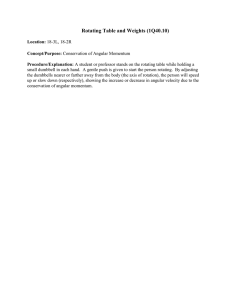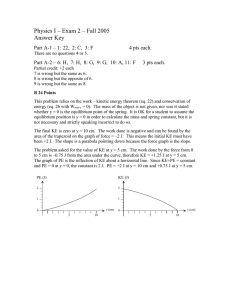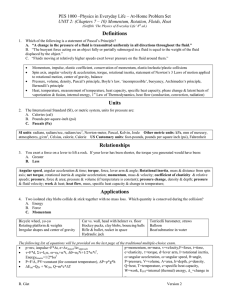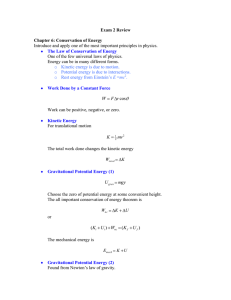ADVANCED PLACEMENT PHYSICS C (Mechanics)
advertisement
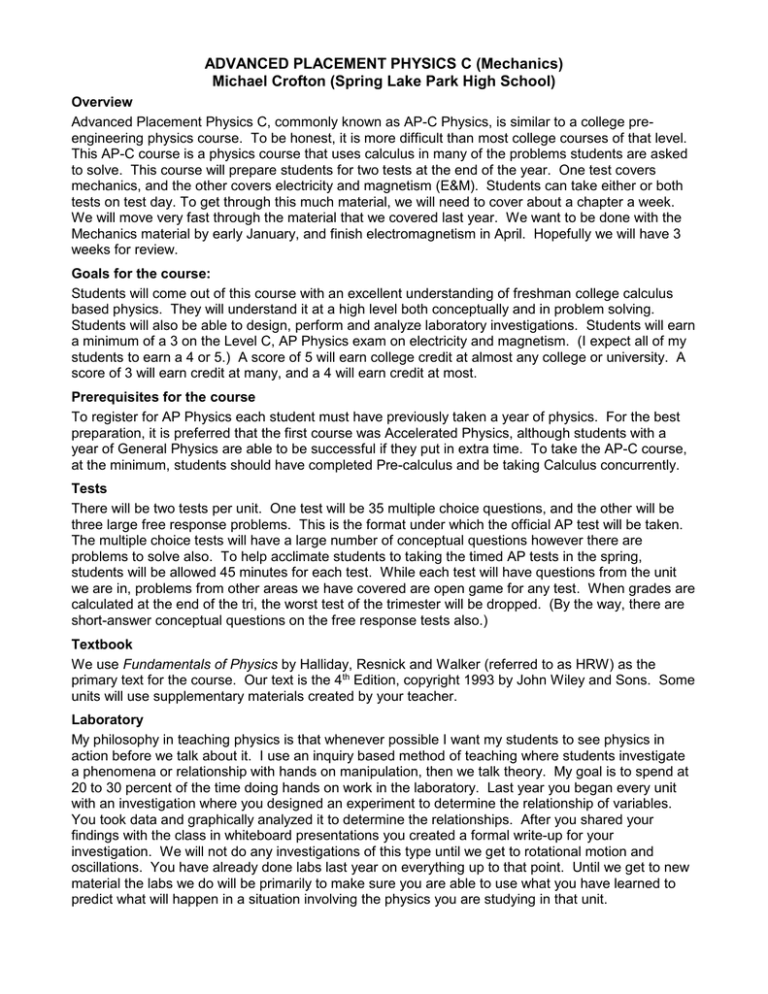
ADVANCED PLACEMENT PHYSICS C (Mechanics) Michael Crofton (Spring Lake Park High School) Overview Advanced Placement Physics C, commonly known as AP-C Physics, is similar to a college preengineering physics course. To be honest, it is more difficult than most college courses of that level. This AP-C course is a physics course that uses calculus in many of the problems students are asked to solve. This course will prepare students for two tests at the end of the year. One test covers mechanics, and the other covers electricity and magnetism (E&M). Students can take either or both tests on test day. To get through this much material, we will need to cover about a chapter a week. We will move very fast through the material that we covered last year. We want to be done with the Mechanics material by early January, and finish electromagnetism in April. Hopefully we will have 3 weeks for review. Goals for the course: Students will come out of this course with an excellent understanding of freshman college calculus based physics. They will understand it at a high level both conceptually and in problem solving. Students will also be able to design, perform and analyze laboratory investigations. Students will earn a minimum of a 3 on the Level C, AP Physics exam on electricity and magnetism. (I expect all of my students to earn a 4 or 5.) A score of 5 will earn college credit at almost any college or university. A score of 3 will earn credit at many, and a 4 will earn credit at most. Prerequisites for the course To register for AP Physics each student must have previously taken a year of physics. For the best preparation, it is preferred that the first course was Accelerated Physics, although students with a year of General Physics are able to be successful if they put in extra time. To take the AP-C course, at the minimum, students should have completed Pre-calculus and be taking Calculus concurrently. Tests There will be two tests per unit. One test will be 35 multiple choice questions, and the other will be three large free response problems. This is the format under which the official AP test will be taken. The multiple choice tests will have a large number of conceptual questions however there are problems to solve also. To help acclimate students to taking the timed AP tests in the spring, students will be allowed 45 minutes for each test. While each test will have questions from the unit we are in, problems from other areas we have covered are open game for any test. When grades are calculated at the end of the tri, the worst test of the trimester will be dropped. (By the way, there are short-answer conceptual questions on the free response tests also.) Textbook We use Fundamentals of Physics by Halliday, Resnick and Walker (referred to as HRW) as the primary text for the course. Our text is the 4th Edition, copyright 1993 by John Wiley and Sons. Some units will use supplementary materials created by your teacher. Laboratory My philosophy in teaching physics is that whenever possible I want my students to see physics in action before we talk about it. I use an inquiry based method of teaching where students investigate a phenomena or relationship with hands on manipulation, then we talk theory. My goal is to spend at 20 to 30 percent of the time doing hands on work in the laboratory. Last year you began every unit with an investigation where you designed an experiment to determine the relationship of variables. You took data and graphically analyzed it to determine the relationships. After you shared your findings with the class in whiteboard presentations you created a formal write-up for your investigation. We will not do any investigations of this type until we get to rotational motion and oscillations. You have already done labs last year on everything up to that point. Until we get to new material the labs we do will be primarily to make sure you are able to use what you have learned to predict what will happen in a situation involving the physics you are studying in that unit. In units that do not lend themselves to taking data, such as gravitation, we will be using a programming language called Vpython. Students will write programs in VPython to visually model on the computer the concepts they are studying. Practicums Last year you were introduced to practicums. They were situations where a setup of equipment was presented to you and a problem was posed by your teacher. As a class you gathered data and then tried to figure out the answer to the problem. Then the equipment was activated and you saw whether or not you were correct. Most units in AP mechanics will end with a practicum. In a way they are also a type of lab. You will have a class period to solve for the answer. Ten minutes before the end of the period a student will be drawn to present the answer. The grade of each person in the class will depend on the correctness of their presentation and their ability to explain the physics involved in the solution. Mechanics Unit 1: Kinematics Chapters 2 and 4 in HRW Textbook (Approximately 1.5 weeks) Major topics: Review of position, displacement, speed, average and instantaneous velocity. Motion in a straight line with constant acceleration or no acceleration Motion with time varying acceleration requiring calculus (differentiation and integration) to analyze Relative motion in inertial frames of reference Projectile motion in 2 dimensions Inward acceleration of an object in uniform circular motion Lab Uniformly accelerated motion and constant velocity motion (Students determine the meeting point of an object moving with constant acceleration and another moving with constant velocity. It is a hands on lab where students determine that acceleration of a ball rolling down a ramp and a toy car moving at a constant velocity. They then use these values to determine the location where the ball will be even with the front of the car. The lab takes one class period.) *Last year the students did a hands on two day lab with toy cars where they experimentally derived the equation xf = v t + xi. *Last year the students did a hands on four day lab where they experimentally derived the equations x f = 21 at 2 +x i , v f =at+vi , and v 2f =2ax+v i2 . *Last year students did a hands on in one day lab where they calculated where to place a target on the floor so a ball rolled down a ramp and off the lab table would land on the target. Photogates are placed just before the edge of the table to assist in determining the velocity. Practicum Question posed: Given the height of a projectile launcher and the location of the target, determine the angle the projectile launcher must be set at so that a projected steel ball lands on the target. (The practicum takes one class period.) Practice problems in HRW Chapter 2: 12, 13, 14, 16, 19, 22, 23, 26, 29, 46, 50, 53, 54, 55, 56, 58, 60, 67, 68, 69, 71, 77, 78, 79, 83, 87, 92, 97, 99 Chapter 4: 3, 5, 8, 11, 12, 14, 16, 17, 21, 25, 27, 33, 34, 37, 40, 41, 52, 57, 59, 62, 64, 67, 69, 72, 74, 77, 81, 83, 86, 88, 97 Unit 2: Forces and Motion Chapters 5 and 6 in HRW Text (Approximately 2 weeks) Major topics: Free-body diagrams Forces in equilibrium Newton’s Laws of Motion 2nd Law problem solving Friction force Inward (Centripetal) forces that lead to uniform circular motion 2nd Law problem solving that require the use of differential equations (Although I placed them in this unit which we are doing in September, we do not actually work on them until we are done with E&M in April. We need to allow your skills in calculus to advance before tackling differential equations.) Lab Toy airplane lab (A hands on lab where a toy airplane travels in a horizontal circle at the end of a string. Students calculate the speed of the plane and use it to solve for the angle at which the string should be. They then check it using the geometry of the flight. The lab takes one class period.) *Last year students did a hands on three day lab where they experimentally derived the equation a= Fnet . m mv 2 *Last year students did a two day hands on lab where they experimentally derived the equation Fc = . r Practicum Question posed: Given the mass of the glider and the suspended pulley, determine the acceleration of the glider. (The practicum takes one class period.) glider and flag photogates ring stands air track Suspended pulley Practice problems in HRW Chapter 5: 40, 41, 49, 50, 52, 58, 62, 76 Chapter 6: 3, 4, 11, 12, 14, 16, 22, 25, 29, 30, 32, 34, 35, 36, 39, 47, 51, 56, 58, 61, 63, 67, 70, 75, 78, 79 Unit 3: Energy and Conservation of Energy Chapters 7 and 8 in HRW Textbook (Approximately 2 weeks) Major topics: Work as a method of transferring energy Work done by a constant force Work done by a variable force Solving graphically using area of a force versus position graph Solving by integrating F(x)dx Definition of potential energy Kinetic energy Gravitational energy Power Hooke’s Law and elastic energy Conservative and non-conservative forces Work done by the force of friction Discussion of where the energy “lost” due to friction is now located Conservation of Energy Potential Energy Curves Lab Hooke’s Law and energy in a spring (A hands on lab where students take data for force versus spring stretch while hanging weights on a spring. They then derive the equation known as Hooke’s Law. They then use the spring to accelerate a mechanics cart. By integrating Hooke’s Law they determine the energy transferred from the spring to the cart and graph it versus the velocity of the cart. They see that the energy “lost” by the spring is equal to the kinetic energy of the cart. The lab takes two class periods.) *Last year students did a hands on lab where they experimentally derived the formula for kinetic energy by graphing work that the earth does accelerating a cart down a ramp and the speed of the cart on the ramp. Practicum Question posed: If the ball is pulled to the side until the string is horizontal, what is the minimum distance (“y”) the bar can be from the support for the string to remain taut as the ball circles over the bar. (The practicum takes one class period.) support y bar string ball Practice problems in HRW Chapter 7: 2, 5, 9, 13, 15, 16b, 17, 20, 26, 33, 36, 37, 38, 42, 43, 44, 45, 53, 55 Chapter 8: 7, 11, 16, 17, 18, 23, 25, 26, 27, 30, 31, 32, 34, 36, 38, 40, 41, 48, 59, 62, 66, 68, 71, 74, 84, 88, 89, 103, 104, Unit 4: Momentum, Impulse and Conservation of Momentum Chapters 7 and 8 in HRW Textbook (Approximately 2 weeks) Major topics: Center of mass and its special properties Solving for the location using algebraic methods and calculus (integration) methods Momentum Impulse and change in momentum Solving for impulse and change in momentum using the area of a force versus time graph Solving using the integral of Fdt The time derivative of momentum as the net force Conservation of Momentum Collisions and the motion of the center of mass Elastic and inelastic collisions Collisions in two dimension Labs Ballistic pendulum lab (A hands on lab where students use a projectile launcher to shoot a ball bearing into a hanging ball catcher and use conservation of energy and conservation of momentum to solve for the speed of the ball. The lab takes one class period.) Collisions in two dimensions (A hands on conceptual lab where students explore glancing elastic collisions of two steel spheres and a steel and an aluminum sphere. One sphere rolls down a ramp and strikes the other and their landing locations are located. From this the students prove that momentum is conserved. The lab takes one class period.) *Last year students did a hands on lab where a ball was shot from a projectile launcher into a mechanics cart. They used conservation of momentum to determine the balls velocity. Practicum Question posed: Predict how far and in what direction, the platform will move when the carts on top explode apart. (The practicum takes one class period.) (Practicum invented by Jon Barber.) Velcro Velcro Spring loaded plunger Platform Whiteboard Marker Upside down carts to support platform (low friction) Practice problems in HRW Chapter 9: 3, 4, 5, 7, 9, 11, 13, 15, 19, 20, 22, 28, 30, 34, 36, 39, 41, 43, 64, 65 Chapter 10: 7, 11, 14, 17, 22, 23, 27, 29, 35, 45, 55, 56, 57, 63, 73, 79, 80, 81, 82 Unit 5: Torque and Rotational Mechanics (Approximately 4 weeks) Part 1: Torque and Rotational Equilibrium, Rotation about an axis Chapters 11 and part of 13 in HRW Textbook Major topics: Collisions in two dimension Torque Static equilibrium involving torque Kinematics variables for rotational motion Rotational motion with constant angular acceleration Rotational motions with time varying angular acceleration motion requiring calculus (differentiation and integration) to analyze Moment of inertia Solving algebraically for the value using point masses Solving using calculus (integrating) for the value of a system of particles (rods and discs) Solving using the parallel axis theorem Torque and angular acceleration Work involved in changing an objects rate of rotation Kinetic energy of a rotating object Power involved in changing an objects rate of rotation 2nd Law problem solving involving rotation Solving for angular velocity using conservation of energy Labs Torque lab (A hands on lab where students hang masses on a meterstick supported horizontally at the center of mass. They determine the conditions necessary to balance a meterstick. The lab takes one class period.) Moment of inertia of a disk (Hands on lab where string is wrapped around a solid disk. Weights are hung on the end of the string and cause the disk to rotate with a constant angular acceleration. Data is taken to determine the moment of inertia of the disk. The lab takes one class period.) Angular acceleration of a composite body (A hands on lab where a system made of more than one of the following is constructed. Objects available are rods, point masses, hollow cylinders, disks and a platform. The system will be caused to go into rotation due to a string wrapped around a pulley underneath the system. On the other end of the string is a descending mass hooked on the string. Students will determine the rate of acceleration of the mass and then use a photogate on the pulley to see if they are correct. The lab takes one class period.) Practice problems in HRW Chapter 13: 12, 13, 14, 21, 25, 27, 33, 35, 39, 40 Chapter 11: 4, 6, 15, 29, 32, 36, 43, 49, 53, 54, 57, 62, 67, 69, 70, 72, 73, 75, 79, 82, 83, 86, 89, 91, 94, 95 Unit 5: Torque and Rotational Mechanics Part 2: Rolling and Angular Momentum Chapter 12 in HRW Textbook Major topics: Rolling: translational motion and rotational motion combined Energy of rolling objects Problem solving for rolling objects using conservation of energy 2nd Law problem solving for object with translational and rotational motion Definition of angular momentum For a particle For a system of particles The time derivative of angular momentum as the net torque Rotational impulse and change in angular momentum Conservation of angular momentum Conservation of both angular and translational momentum Objects sliding with no rotational motion and ending up rolling without sliding Objects on a surface spinning initially without translational motion and ending up rolling without slipping Lab Rolling Bodies (A hands on conceptual lab where students are given different objects to roll down lab tables propped up on one end. They make predictions as to which object will “win” the race down the table and then see if they are correct. At the end of the lab the teacher shows them four plastic disks and tells them the positions of the ball placed inside. (But they don’t know which disk has which setup.) They instruct the teacher what to roll and they watch which one “wins”. At the end they match the disk to the geometry of the balls inside the disks. The lab takes one class period.) Target Lab (Hands on lab where students take data to calculate where to place a target on the floor so a ball rolled down a ramp and off the lab table would land on the target. Conservation of energy is used to determine the velocity of the ball at it leaves the table. The lab takes one class period.) Practice problems in HRW Chapter 12: 4, 7, 8, 10, 12, 13, 14, 16, 20, 21, 22, 23, 24, 25, 27, 30, 34, 36, 37, 38, 39, 42, 43, 45, 46, 50, 51, 53, 54, 55, 56, 58, 61, 64, 65, 68, 70, 72, 73 Unit 6: Oscillations and Simple Harmonic Motion Chapter 14 in HRW Textbook (Approximately 2 weeks) Major topics: Kinematics equations for simple harmonic oscillations Restoring force as a requirement for simple harmonic motion Force and acceleration are directly proportional to the negative of the position The relationship of frequency and angular frequency Relating simple harmonic motion to forces Mass spring systems Simple pendulums Energy considerations for a mass/spring system simple harmonic motion Deriving the angular frequency by using Newton’s 2nd Law (Fnet = m2x) Relating a restoring torque to simple harmonic motion Physical pendulums Relating simple harmonic motion to uniform circular motion Labs Relationship of variables for an oscillating spring/mass system (A hands on lab where students determine the relationship of the period and the mass, the period and spring constant, and the period and the amplitude for a mass oscillating vertically on a spring. They take data and graphically analyze it to produce the equation =2 m k . The lab takes two class periods.) Kinematics and dynamics of simple harmonic motion (Hands on lab where students us a motion detector and a force probe to graph position, velocity, acceleration and net force versus time for a vertically oscillating mass/spring system. The lab takes one class period.) Energy in simple harmonic motion (Hands on lab where students use a motion detector and a force sensor to monitor elastic energy, kinetic energy and gravitational energy versus time for a vertical oscillating mass/spring system. This lab and the one below are done together in a class period.) Energy as a function of position (Students predict the appearance of graphs of kinetic energy versus position and of elastic energy versus position for a mass/spring system. Check using a motion detector.) Practicum Question posed: Given a spring and a set of masses, determine the mass that must be placed on the spring for the system to oscillate 15 times in 10 seconds. Practice problems in HRW Chapter 14: 6, 7, 9, 13, 16, 20, 21, 25, 27, 28, 29, 36, 40, 45, 46, 47, 48, 49, 56, 58, 90 Unit 7: Gravitation Chapter 15 in HRW Textbook (Approximately 1.5 weeks) Major topics: Newton’s Law of Universal Gravitation Superposition principle applied to gravitation Gravitation inside a solid body Simple harmonic motion of an object dropped in a tunnel through the earth Gravitational potential energy (More integration) Potential energy of a system Force as the negative gradient of the gravitational potential energy Escape speed Kepler’s Three Laws 1st law – discuss ellipses and the associated vocabulary 2nd law – prove that the law is a result of conservation of angular momentum 3rd law – prove that for circular orbits it is the result of gravity as an inward force Solving for orbital speed of an elliptical orbit using conservation of angular momentum and conservation of energy Total energy for an object in a circular orbit Lab This is a lab done by writing a computer program. Students will write a VPython program that when run will produce a satellite orbiting the earth in a circular orbit. After they have it running they will modify the speed to show what will happen to the orbit if the satellite were to suddenly gain or lose speed. The students get one class period to work and the rest of the time needed is outside of class. Practice problems in HRW Chapter 15: 5, 6, 10, 16, 18, 19, 31, 36, 46, 48, 49, 52, 57, 60, 77, 85, 87

